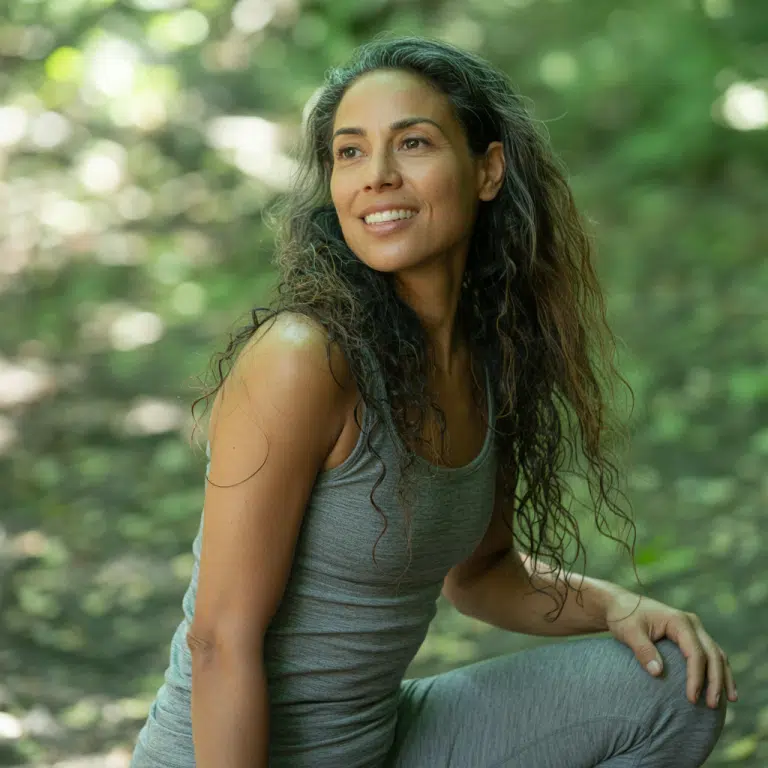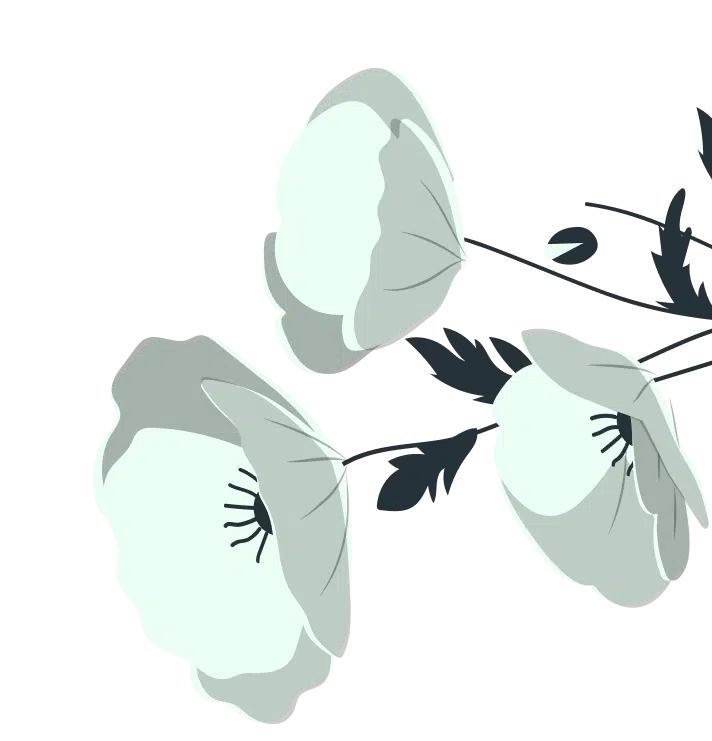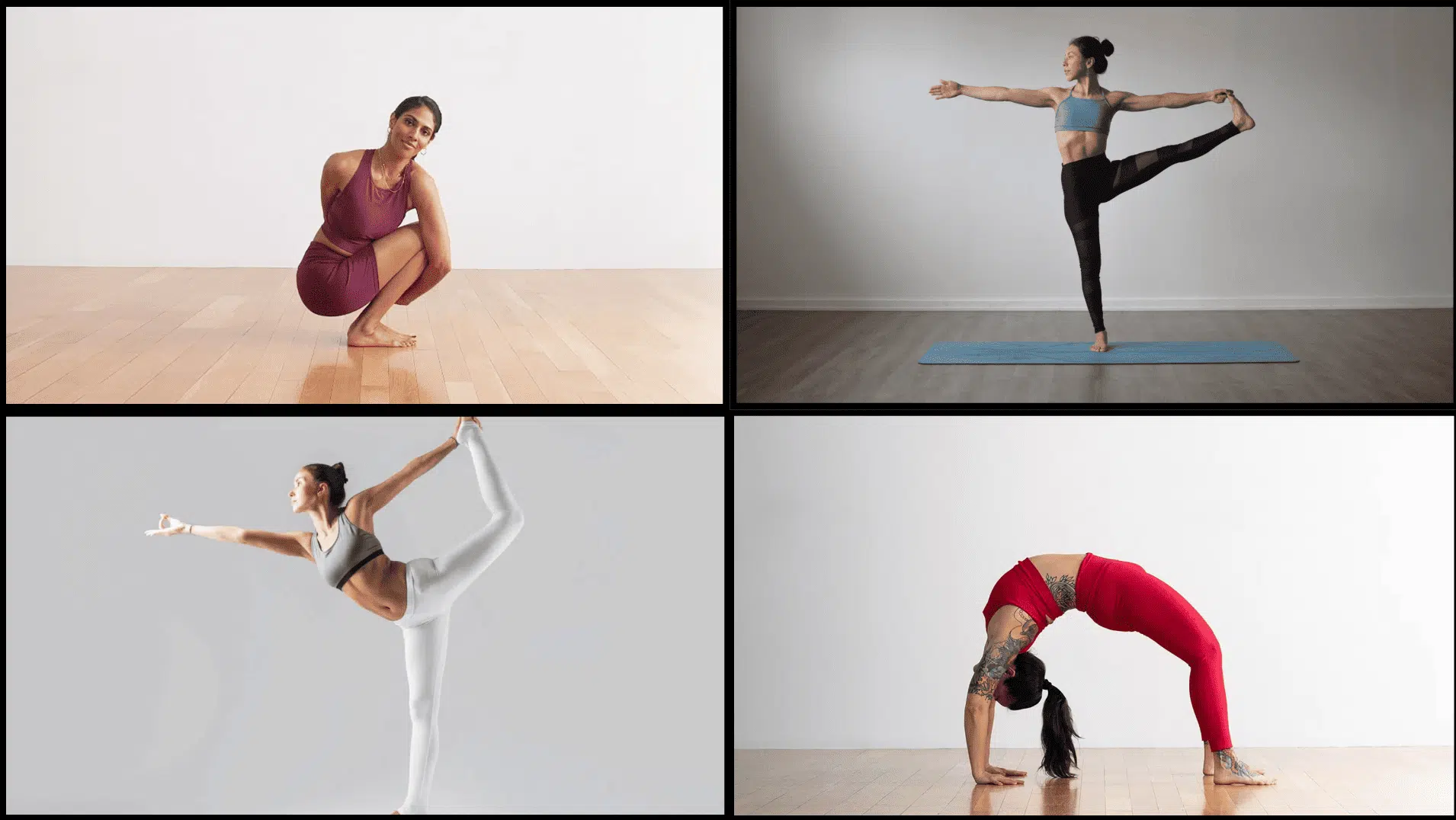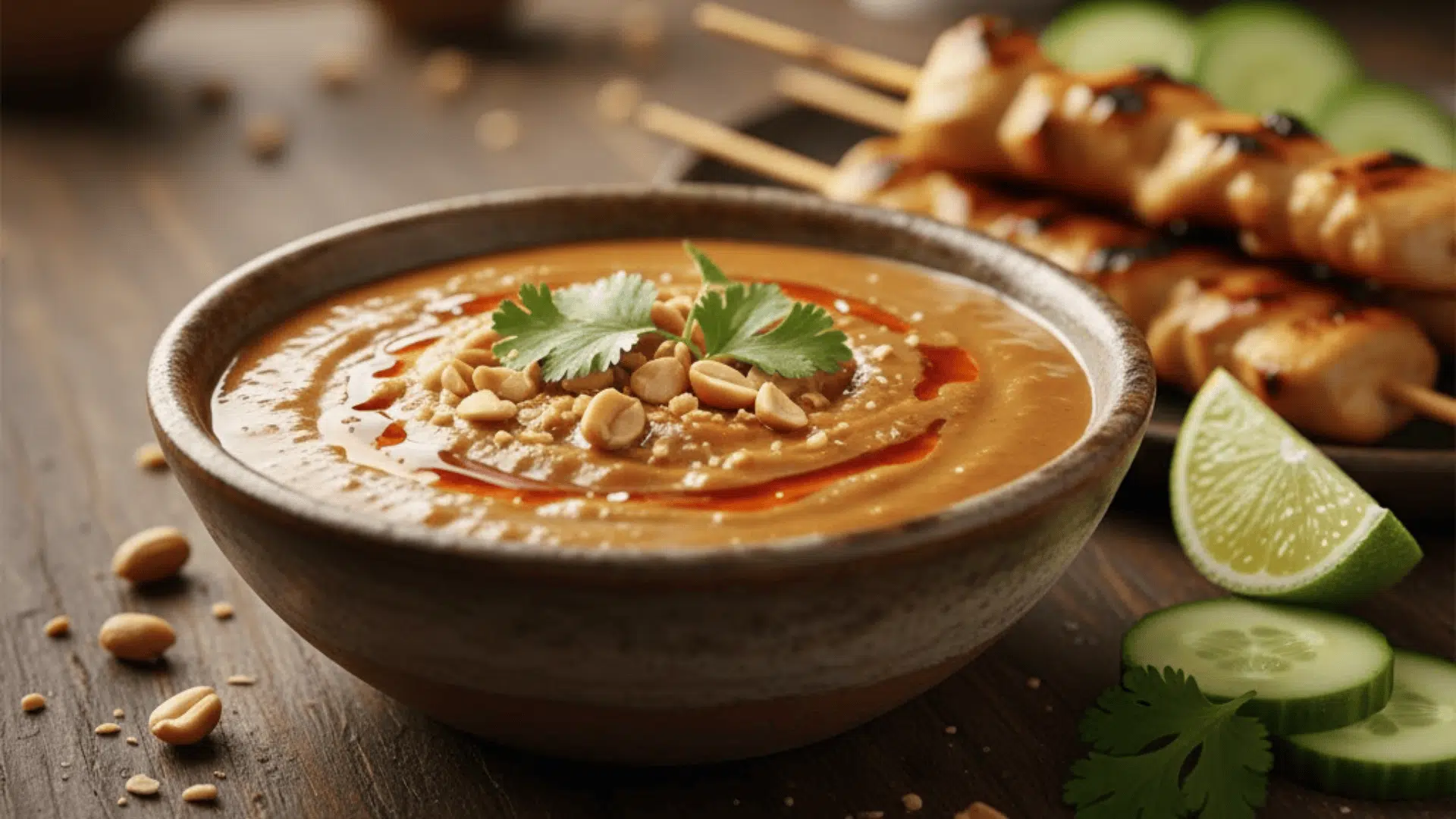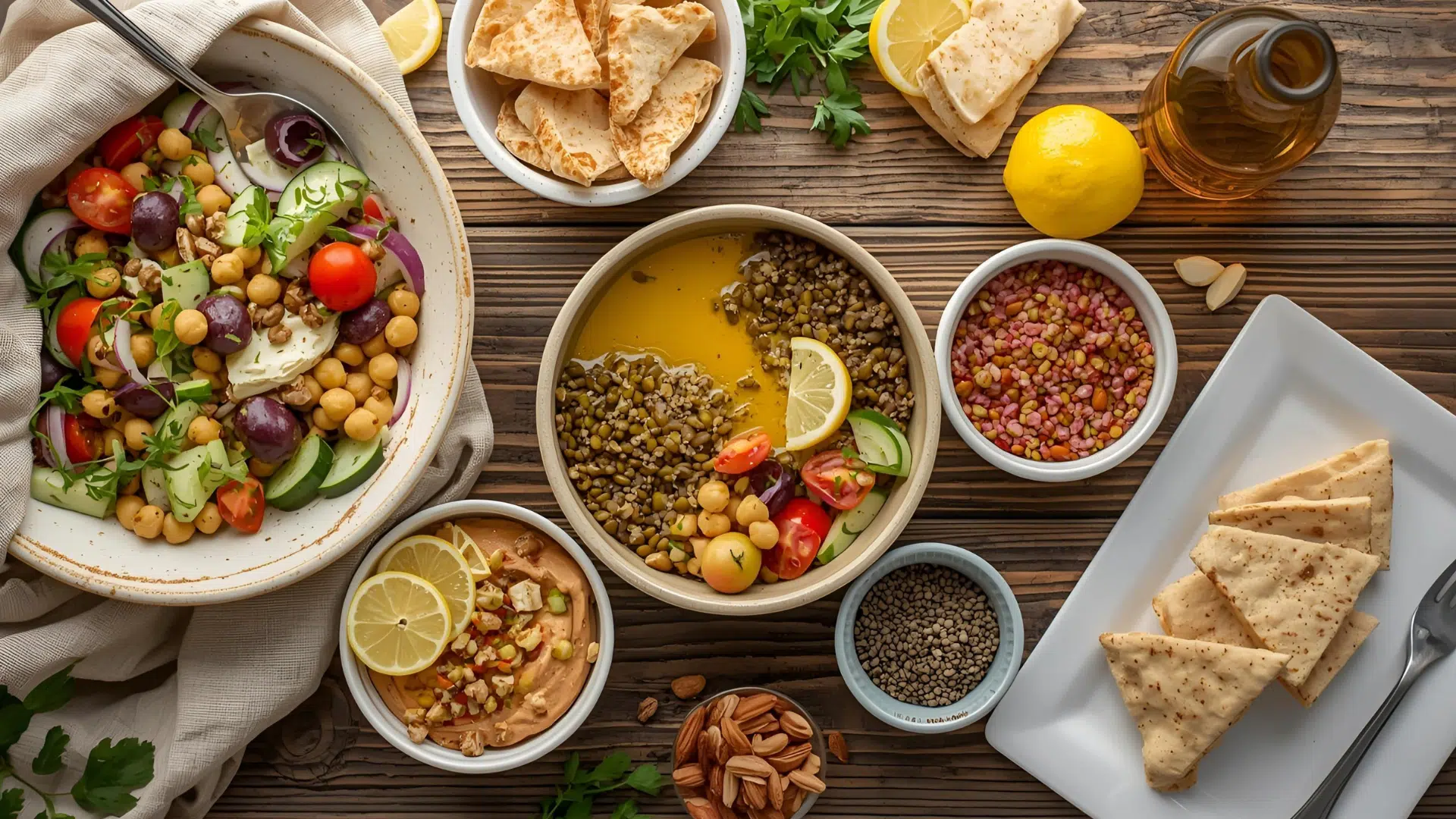Have you ever watched advanced yogis twist into impossible shapes and wondered if normal people can actually do that? I’m excited to share the secrets behind mastering hard yoga poses that will change your practice completely.
You might think these challenging positions are only for super flexible people who started practicing as kids. The truth is that you can learn these incredible moves with the right approach and consistent effort.
Your body is more capable than you realize, and I love helping people find their hidden potential. Most people give up too quickly because they don’t know the proper progression steps that make success possible. Get ready to surprise yourself with what you can achieve!
What Makes a Yoga Pose Hard?
Challenging yoga poses combine physical and mental demands that test your body and mind at the same time.
Your muscles need strength to hold difficult positions, while your joints require flexibility to reach proper alignment. Balance becomes tricky when you’re holding poses on one foot or balancing your entire body weight.
The mental side is just as important as the physical challenge you face during practice. You need to control your breathing while your body wants to tense up or give up completely.
Patience becomes essential when poses feel impossible and your mind starts creating negative thoughts. Most hard poses require multiple skills simultaneously, rather than focusing on just one area of challenge.
Some Hard Yoga Poses You Should Know About
I’ve gathered some of the hardest yoga poses that will test your strength, flexibility, and mental focus all at once.
You’ll find everything from arm balances and inversions to deep backbends that push your limits and transform your practice.
1. Peacock Pose (Mayurasana)
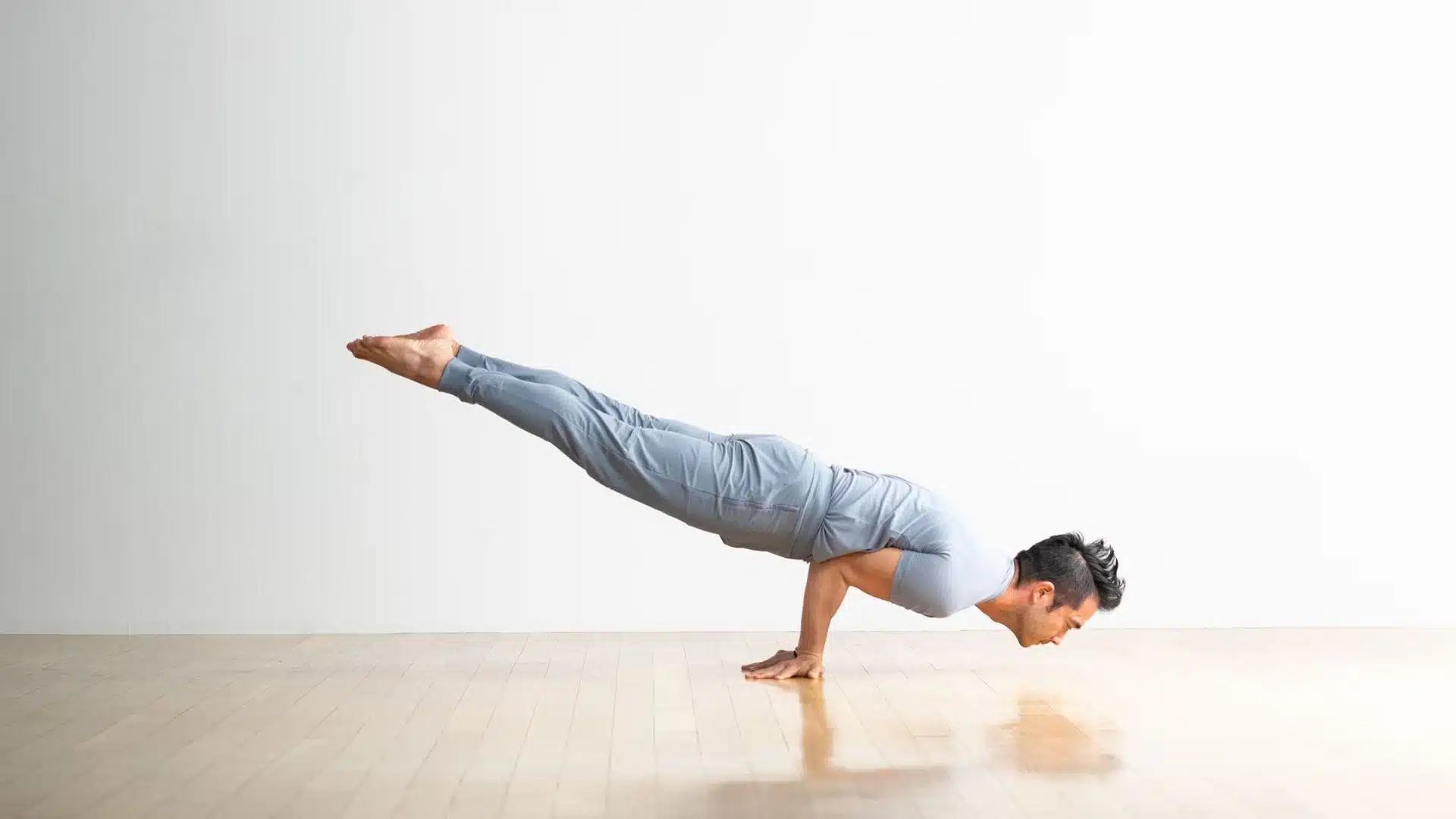

You support your whole body on your hands, elbows pressing into the belly, with legs stretched straight behind you.
Start from kneeling, place your hands close together, and slowly lean forward to lift your legs and feet off the ground. Engage your belly, keep your gaze forward, and stay steady while balancing your weight on strong arms and tight core control.
Benefits
- Builds arm and wrist strength
- Improves digestion and core control
- Increases focus and balance
2. Firefly Pose (Tittibhasana)
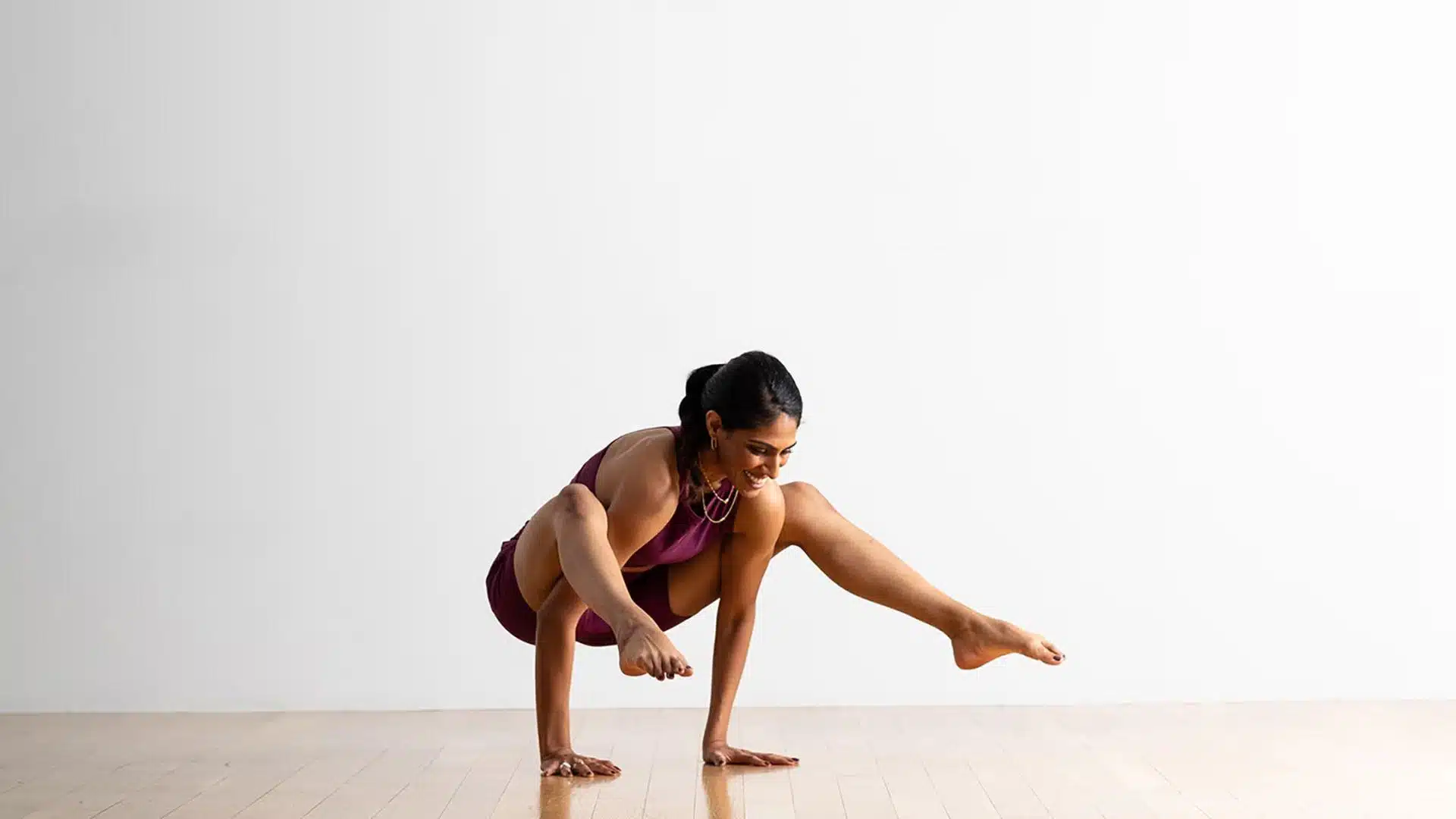

This pose lifts your whole body using your hands while both legs are spread wide on either side of your arms.
Begin in a squat, slide shoulders under your knees, and place hands flat on the floor behind your heels. Shift your weight onto your hands, press firmly, and lift both feet as your legs stretch out wide and strong.
Benefits
- Strengthens arms and wrists
- Opens hips and hamstrings
- Boosts body awareness
3. Eight-Angle Pose (Astavakrasana)
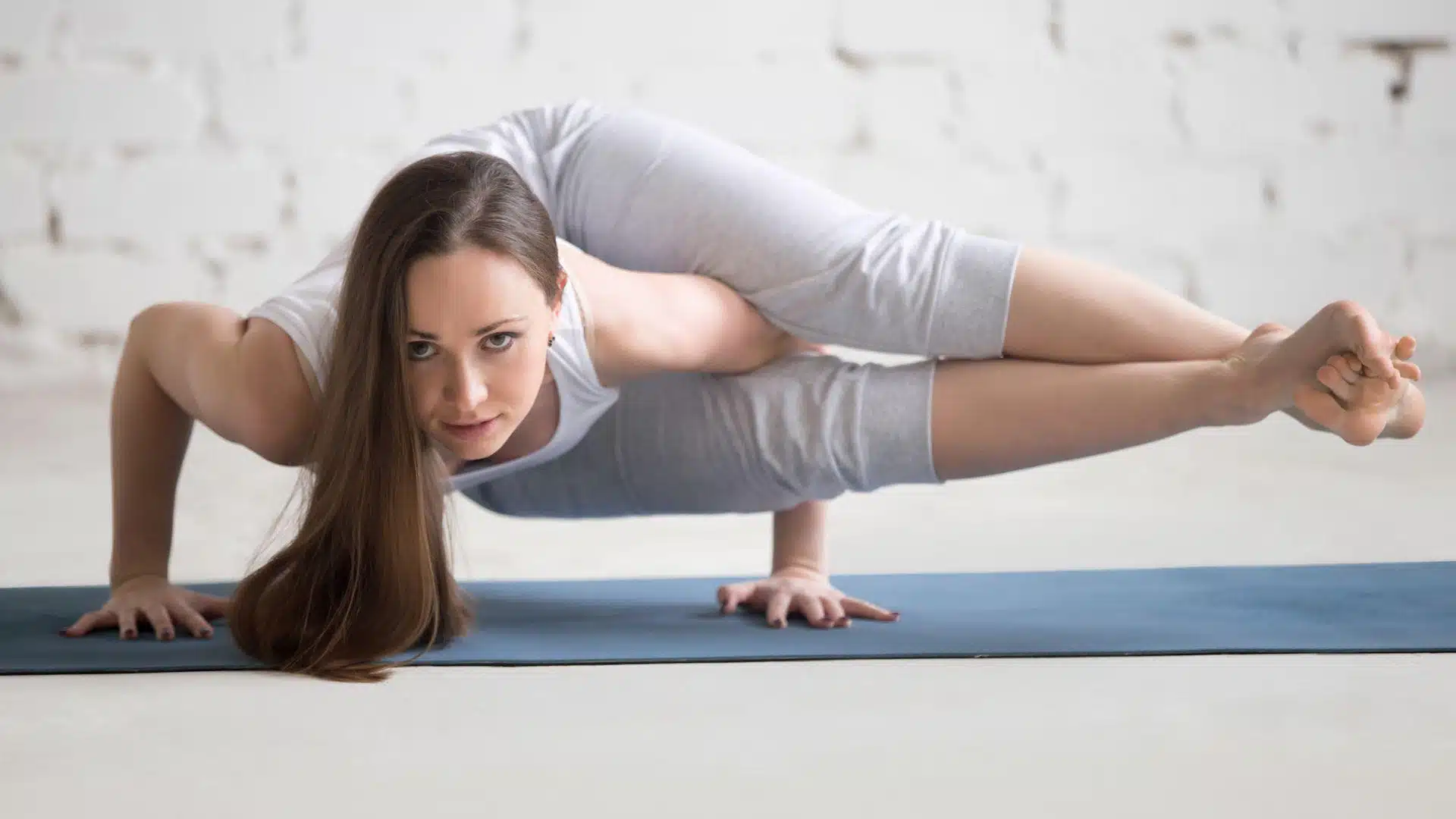

Eight-Angle Pose is a twisting arm balance with crossed legs stretched to the side while your body lifts off the floor. Start seated, hook one knee over the arm, cross your ankles, and place your hands flat beside your hips.
Press into your palms, shift forward, and lift your body with legs extended to one side and spine staying long.
Benefits
- Improves balance and stability
- Builds core and upper-body strength
- Increases body control
4. Flying Pigeon Pose (Eka Pada Galavasana)


This pose balances one bent leg on your arms while the other leg stretches straight behind you in the air.
Start standing, cross one ankle over your thigh, bend forward, and place your palms flat shoulder-width apart. Lean forward, bend your elbows, and lift your back leg up with control while keeping your body strong and steady.
Benefits
- Opens hips deeply
- Strengthens arms and core
- Improves mental focus
5. Forearm Stand (Pincha Mayurasana)
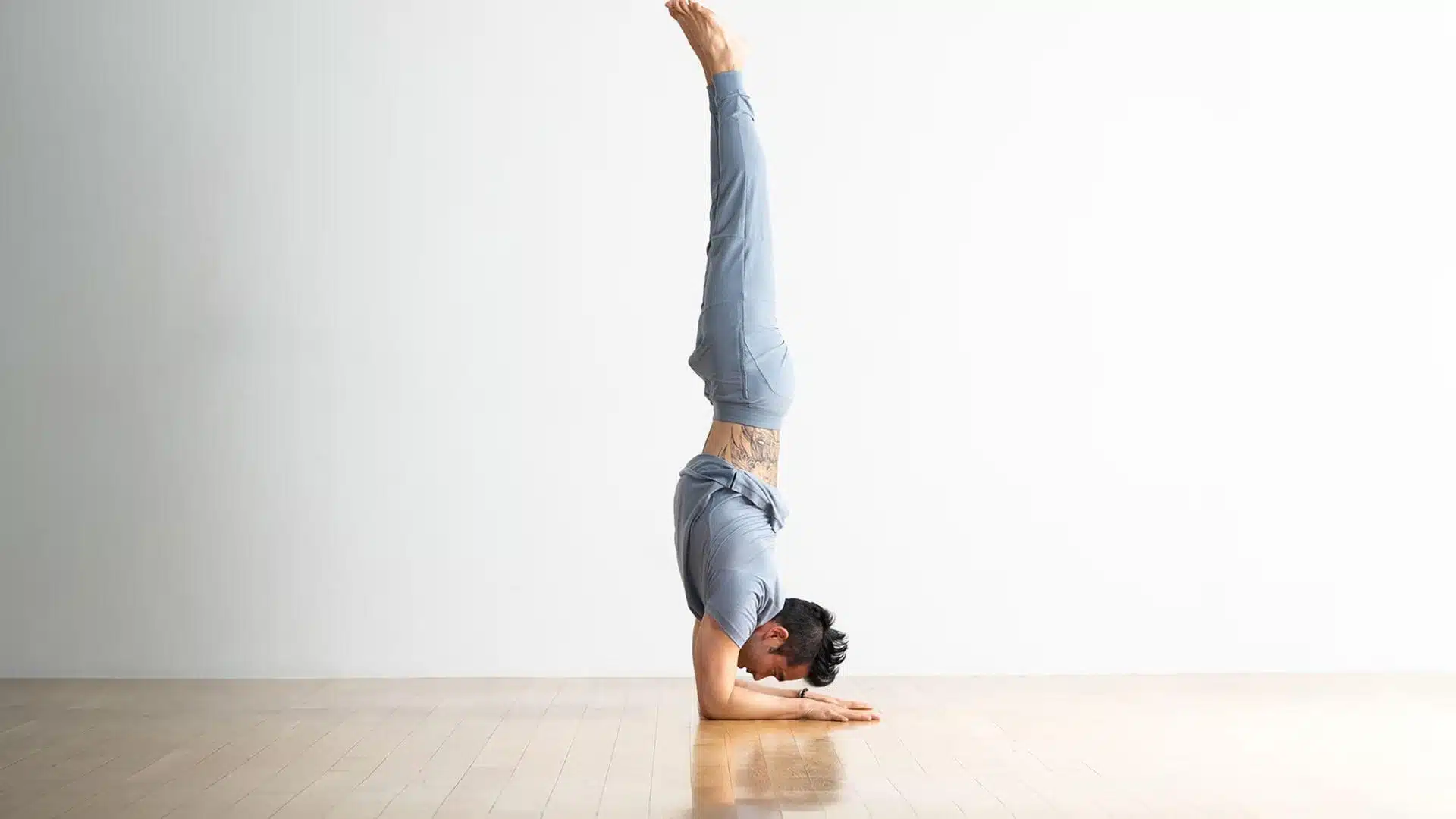

Forearm Stand turns your body upside down while balancing on your forearms with legs stacked above your shoulders and hips. Start in dolphin pose, press down firmly through your forearms, and walk your feet closer to your elbows.
Kick one leg up, engage your core, and lift the other leg to balance with your body fully vertical and stable.
Benefits
- Strengthens shoulders and core
- Improves balance and confidence
- Stimulates blood flow
6. Handstand (Adho Mukha Vrksasana)


In a Handstand, your body is completely upside down with both legs lifted straight while you balance on your hands. Start in downward dog, place your hands shoulder-width apart, and kick up slowly using one leg at a time.
Engage your core, stretch your legs upward, and focus your gaze between your hands to stay upright and in control.
Benefits
- Builds upper-body strength
- Improves focus and courage
- Boosts circulation
7. Scorpion Pose (Vrschikasana)


This is a forearm-based inversion where you bend your back deeply to bring your feet toward your head.
Start in a forearm stand with legs lifted and elbows under shoulders, keeping your balance with a steady breath. Slowly bend your knees, arch your back, and guide your toes downward while pressing strong into your arms and shoulders.
Benefits
- Increases spine flexibility
- Builds strong shoulders and arms
- Challenges your balance and patience
8. One-Legged King Pigeon Pose II
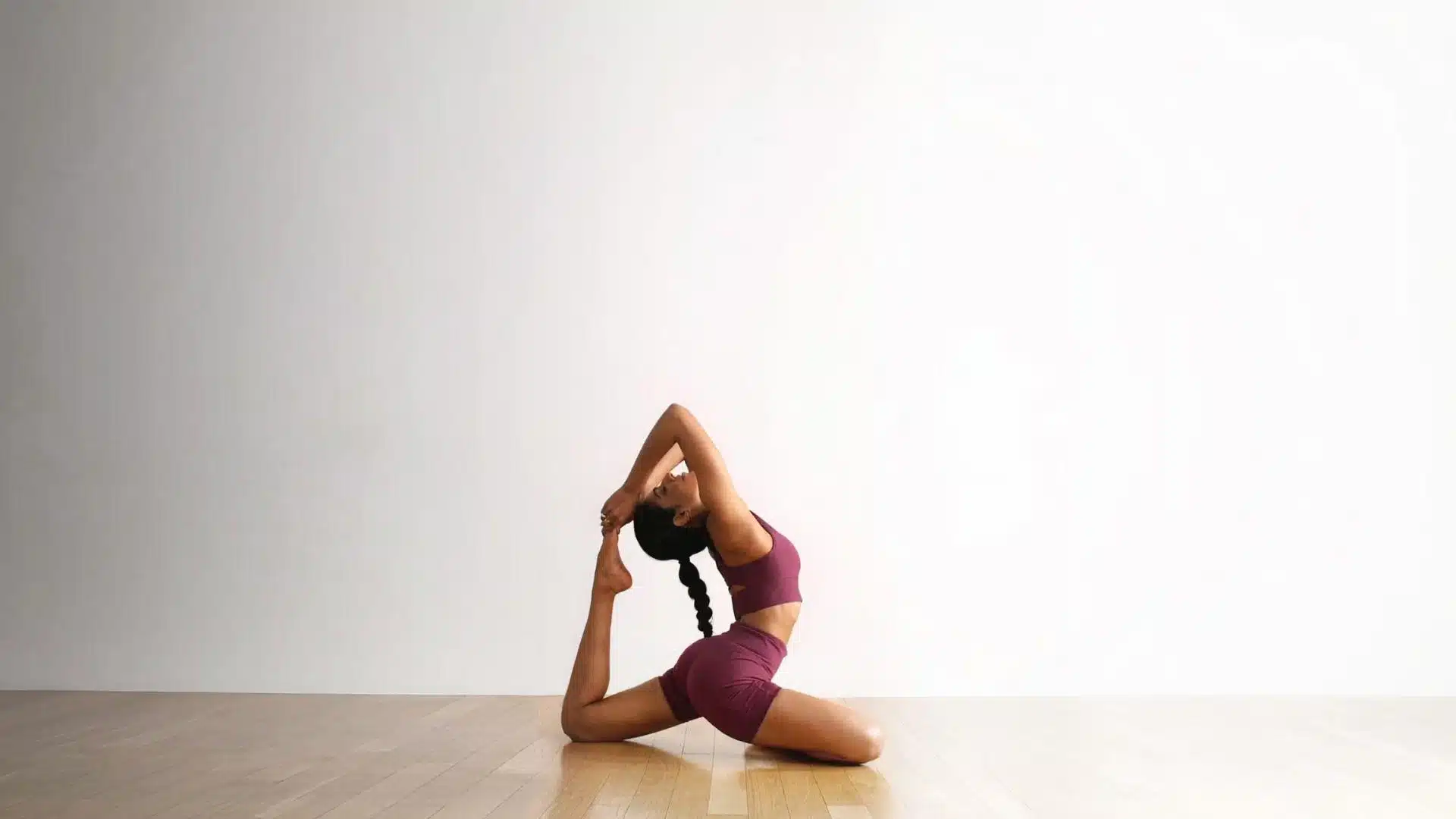

One-Legged King Pigeon Pose II or Eka Pada Rajakapotasana II, mixes a deep lunge with a backbend as you reach back to catch your lifted foot overhead.
Begin in a low lunge, bend the back leg, and slowly bring both hands up to reach for the foot.
Lift your chest, keep your balance, and arch backward with care while pulling the foot closer behind your head.
Benefits
- Stretches hips and thighs
- Opens chest and shoulders
- Improves posture and focus
9. King Pigeon Pose (Kapotasana)
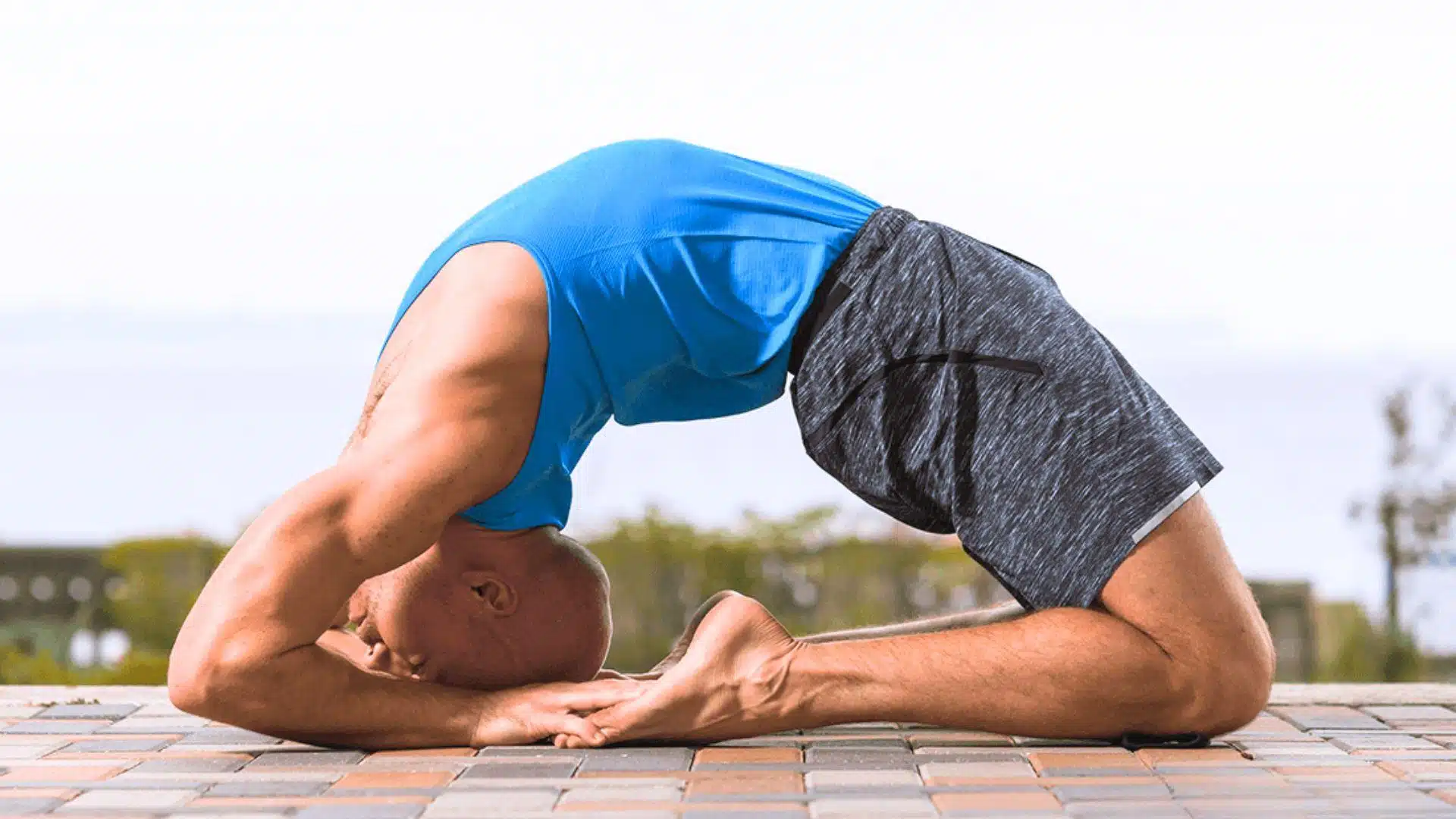

In this pose, your chest opens deeply as your arms reach over your head to touch your feet on the floor.
Start seated on your heels, lift your arms up, and slowly lean back while keeping your spine long and controlled. Reach for your feet behind you, press your hips forward, and hold the backbend while breathing deeply and staying centered.
Benefits
- Opens chest and hip flexors
- Improves spinal flexibility
- Builds courage and focus
10. Foot Behind the Head Pose (Eka Pada Sirsasana)


This is a seated pose where one leg wraps behind your head while your spine stays upright and relaxed. Begin by sitting tall, bend one knee, and lift the foot over your shoulder using both hands for gentle support.
Slowly guide the foot behind your head and hold the position with calm breath and a straight back.
Benefits
- Improves hip flexibility
- Stretches hamstrings and spine
- Boosts patience and calm
11. One-Legged Crow Pose (Eka Pada Bakasana)


This is a variation of the crow where you balance on both arms while one leg lifts back and the other stays bent.
Start in crow pose, shift weight forward, and extend one leg straight behind you with the other knee resting on your arm. Engage your belly and focus your gaze forward to hold steady and control the lifted leg in the air.
Benefits
- Strengthens arms and core
- Improves balance and focus
- Builds hip and leg control
12. Crow Pose (Bakasana)
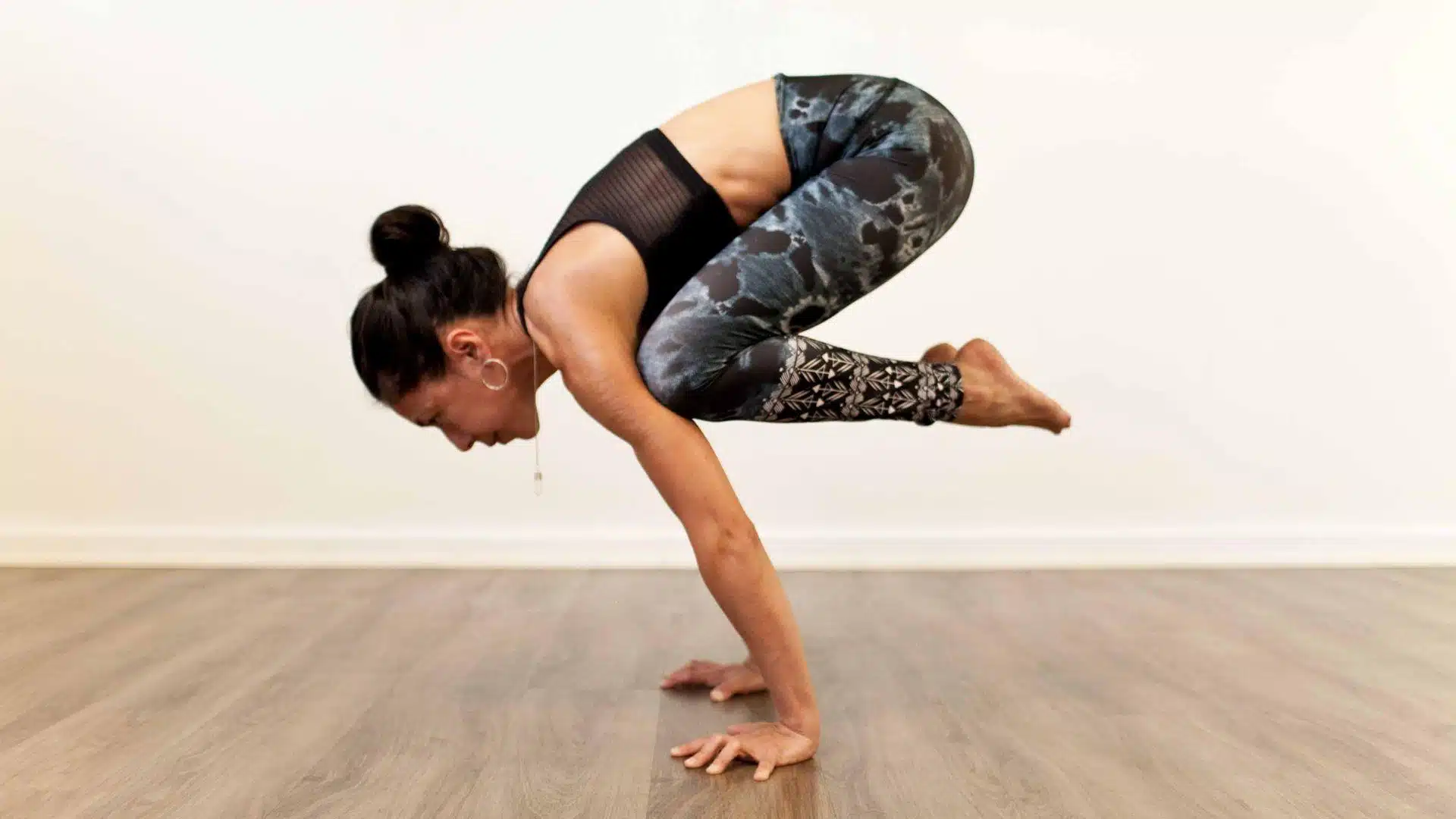

Crow Pose lifts your feet off the floor while balancing on bent arms with knees resting on your upper arms. Start in a squat, place your hands shoulder-width apart, and press your knees into your triceps.
Lean forward slowly, shift your weight, and lift both feet off the floor while tightening your belly and breathing steadily.
Benefits
- Builds arm strength
- Improves coordination
- Boosts core power
13. Crane Pose (Bakasana variation)
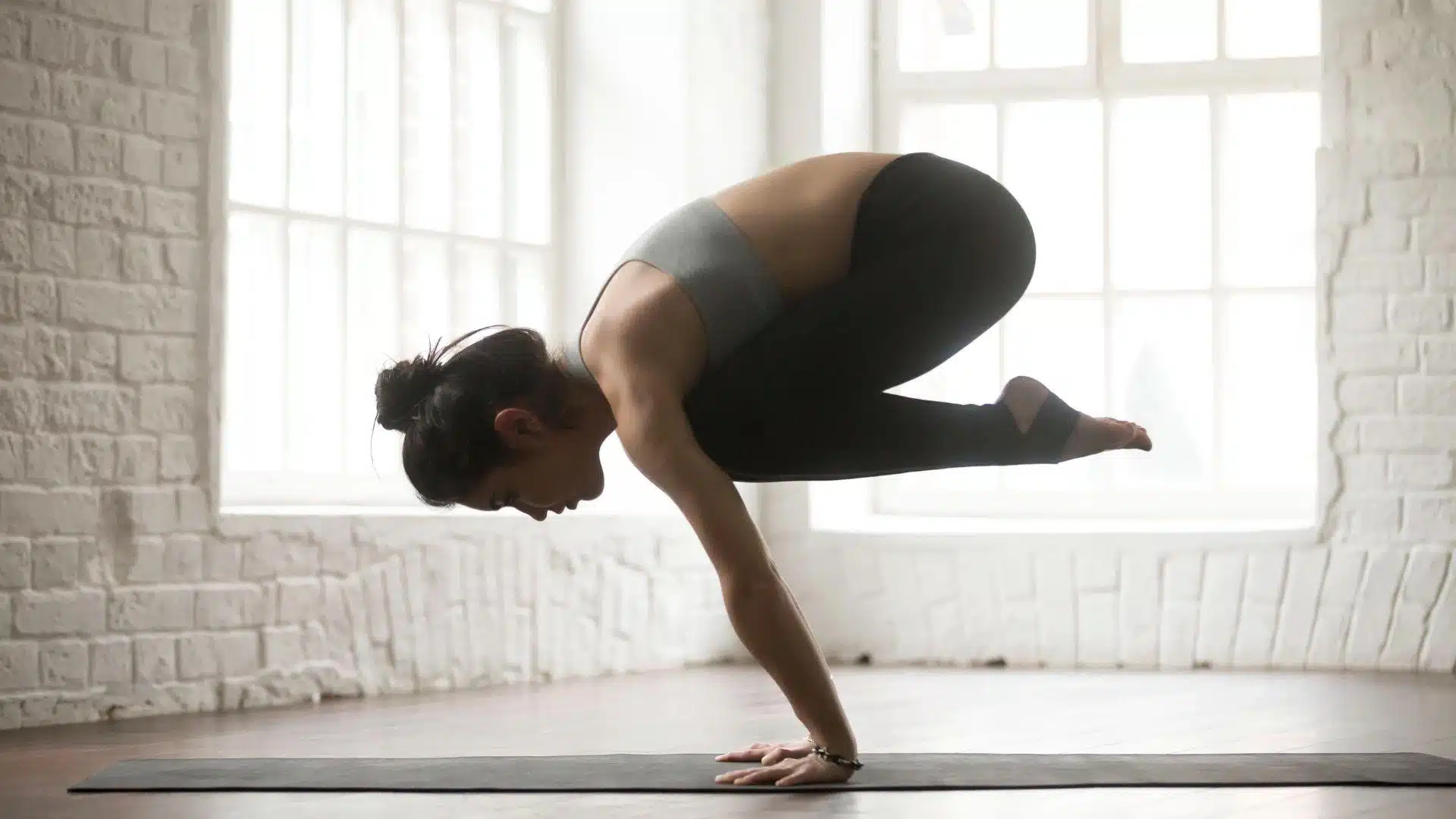

Crane Pose is similar to Crow, but your arms are fully straight while the knees stay on the upper arms. Begin from a low squat, place your palms down, and position your knees high on your triceps or upper arms.
Lean forward, lift both feet, and straighten your arms while using your core and balance to stay lifted and centered.
Benefits
- Builds upper-body control
- Strengthens wrists and arms
- Sharpens body focus
14. Side Crow Pose (Parsva Bakasana)
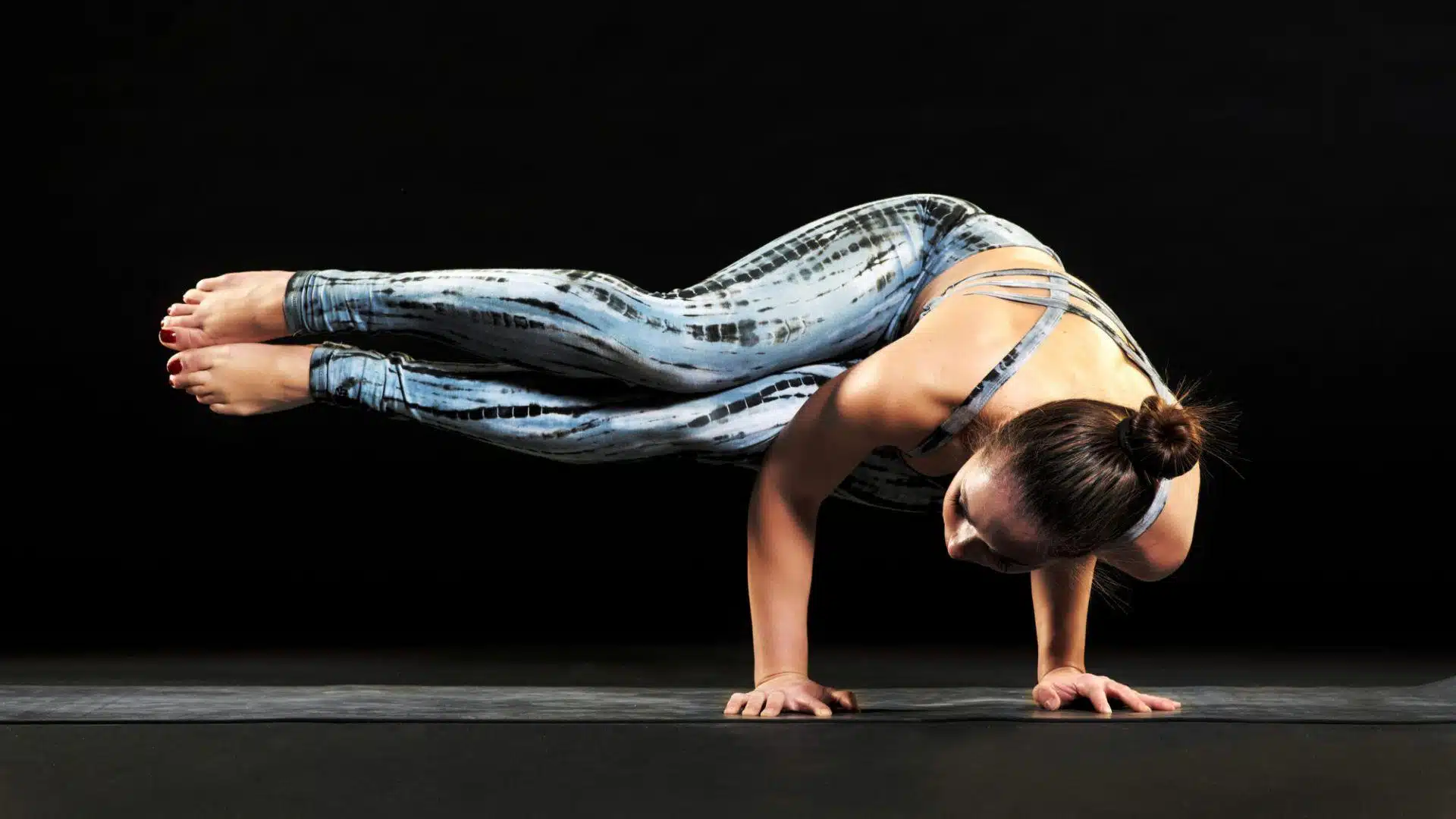

Side Crow adds a twist to your body while lifting both feet off the ground and legs stacked to one side.
From a squat, twist your torso and place your hands down slightly to the side for balance and support. Bend your elbows, shift your weight over your arms, and lift both legs sideways while keeping your core engaged.
Benefits
- Strengthens obliques and arms
- Improves spinal rotation
- Improves balance and awareness
15. Grasshopper Pose (Parsva Bhuja Dandasana)


This pose mixes a deep twist, arm balance, and hip stretch while one leg extends out and the other hooks over an arm. Start in a seated twist, hook one foot on your arm, and plant both hands beside your hips.
Shift your weight forward, press into your palms, and lift the body while keeping the extended leg straight.
Benefits
- Builds hip mobility
- Strengthens arms and shoulders
- Increases focus and control
16. Compass Pose (Parivrtta Surya Yantrasana)
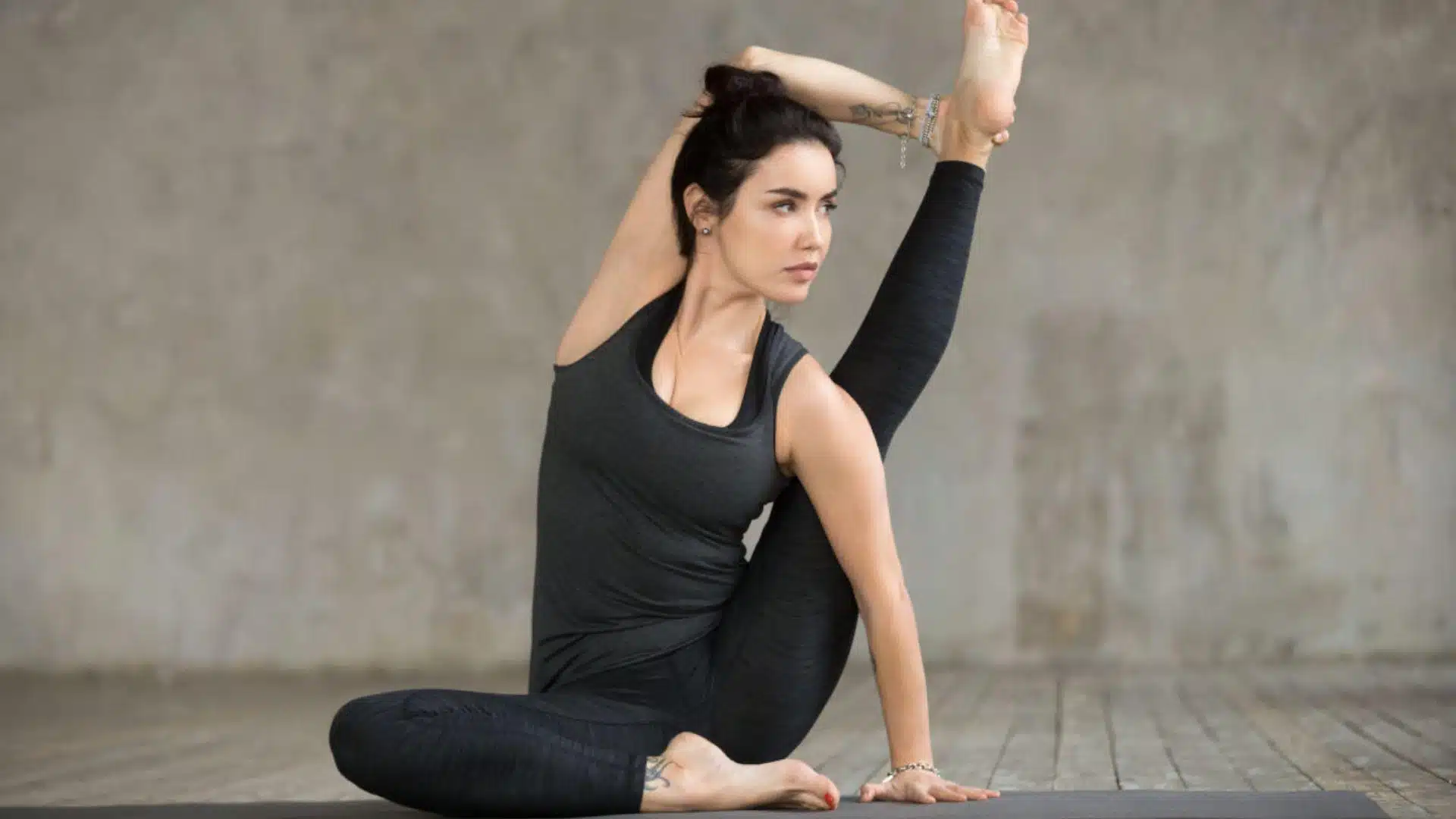

This seated pose stretches one leg beside your head while twisting the torso and keeping the other leg grounded. Start sitting with one leg bent and the other stretched. Thread one arm under your knee and grab the foot.
Hold the foot with your opposite hand, press the other hand into the floor, and extend the leg upward beside your ear.
Benefits
- Increases flexibility
- Opens the side body
- Improves spinal twist
17. Bound Lotus Pose (Baddha Padmasana)


This is a seated pose where the legs are in lotus, while the arms reach behind to grab the toes.
Begin in full lotus, sit tall, and rotate your shoulders as you bring both hands around your back.
Try to catch your toes with your fingers while keeping the spine upright and breathing slowly without forcing the shape.
Benefits
- Opens shoulders and chest
- Improves hip flexibility
- Calms the mind
18. Tortoise Pose (Kurmasana)
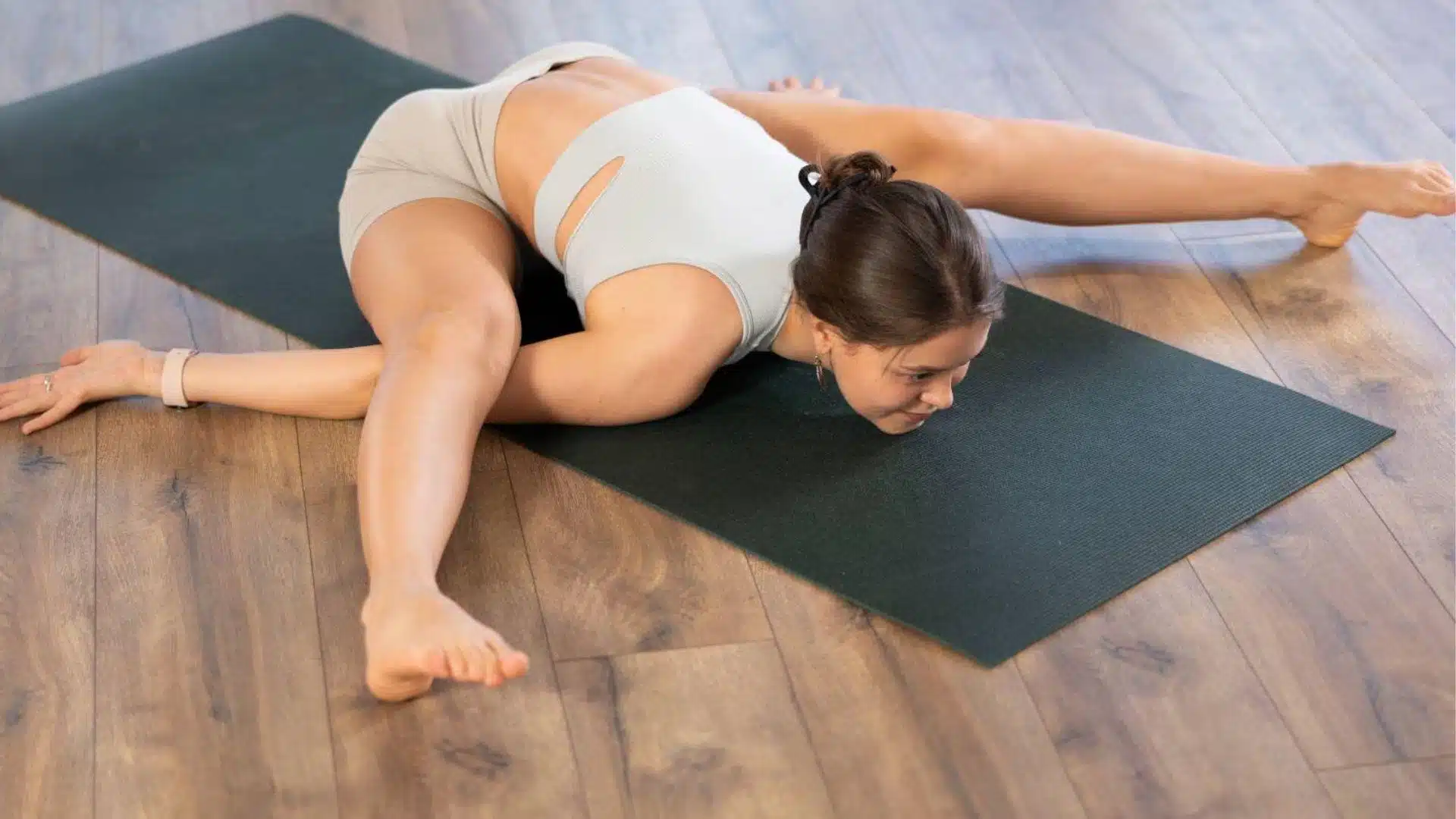

This pose folds your body forward between extended legs with arms stretched underneath and chest low to the floor. Start seated with legs spread slightly wider than hips and feet flexed. Lean forward slowly, sliding your arms under the thighs.
Lower your chest toward the ground, keeping your back flat and head between your knees while reaching the hands outward.
Benefits
- Stretches back and hamstrings
- Calms the nervous system
- Improves flexibility
19. Sleeping Yogi Pose (Yoganidrasana)


This reclining pose tucks both legs behind the head while lying on your back with hands in prayer near the chest. Lie down, bend your knees, and guide your feet behind your shoulders using both hands. Cross your ankles gently behind your head.
Once legs are in place, bring your hands together at your chest and relax into stillness while breathing slowly.
Benefits
- Opens hips and spine
- Encourages deep relaxation
- Improves flexibility
20. Lifted Lotus Pose (Utpluthih)
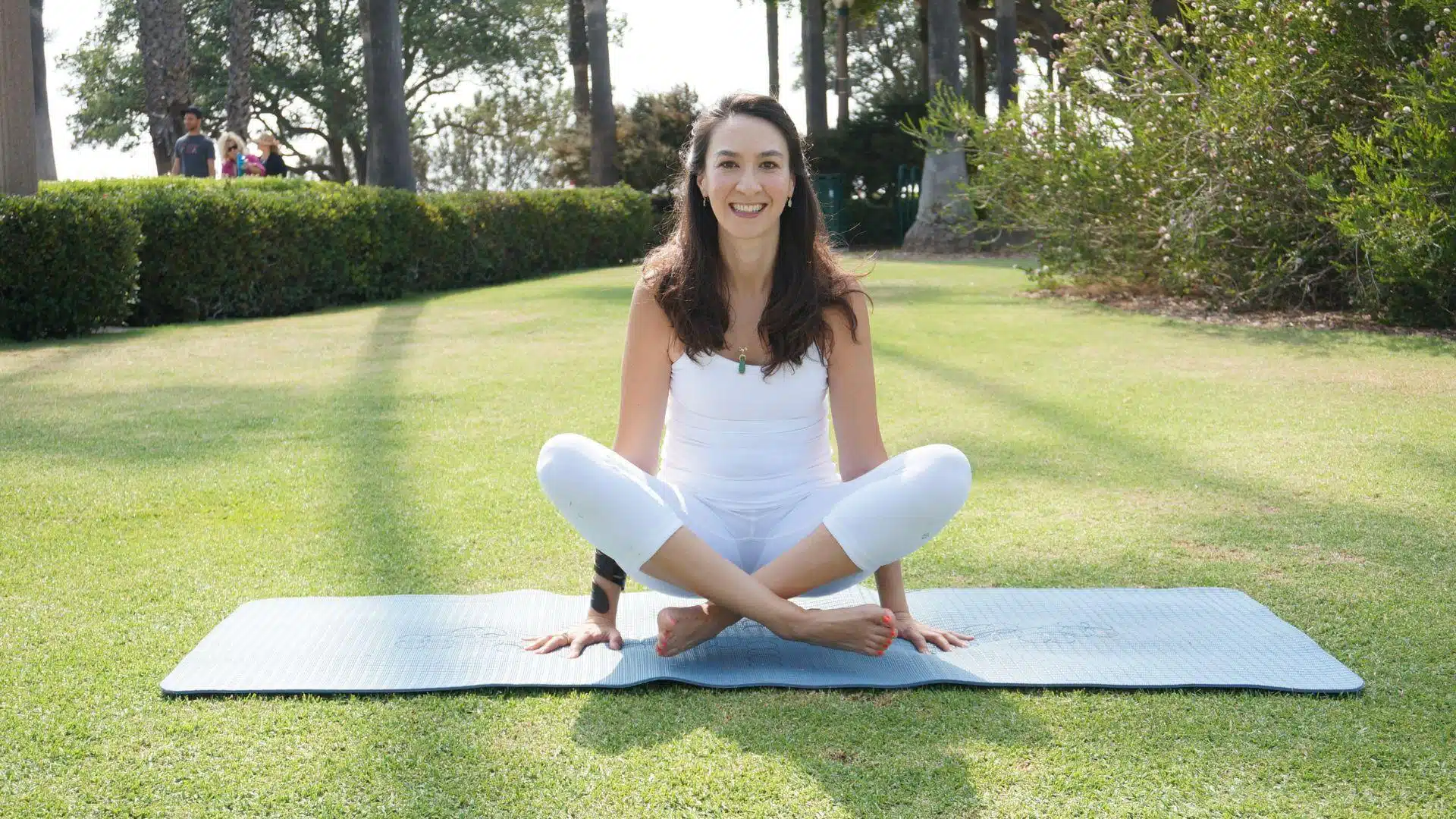

You lift your whole body while seated in lotus by pressing into the ground with your hands beside your hips. Begin in lotus pose, place palms flat on the floor near your sides, and press down strongly through your arms.
Tighten your belly, engage your thighs, and lift yourself off the ground using core strength while breathing steadily.
Benefits
- Builds arm and core strength
- Improves focus and stillness
- Boosts body awareness
21. Bird of Paradise Pose (Svarga Dvijasana)


This is a standing balance pose where one leg is lifted and extended while the hands stay bound behind the thigh.
Start from a forward fold with one leg threaded under your arm and both hands clasped behind your back. Slowly rise up to stand, keep the bound leg lifted, and extend it straight as you find balance and length.
Benefits
- Improves balance and strength
- Stretches hamstrings and shoulders
- Increases control and flexibility
22. Dancer’s Pose (Natarajasana)


Dancer’s pose is a standing backbend where one hand holds the lifted foot while the other arm stretches forward.
Stand tall, bend one knee, and grab your ankle from the inside while reaching the other arm forward. Press your foot into your hand, lean slightly forward, and lift your chest while keeping your balance steady and calm.
Benefits
- Opens chest and shoulders
- Strengthens legs and core
- Improves body awareness
23. Standing Split (Urdhva Prasarita Eka Padasana)


This standing pose lifts one leg straight up while the hands reach toward the floor beside the grounded foot. Begin in a forward fold, shift your weight onto one leg, and lift the other leg high behind you.
Keep the lifted leg strong, engage your standing leg, and draw your chest toward your shin while staying balanced.
Benefits
- Stretches hamstrings and hips
- Builds leg strength and control
- Improves balance and focus
24. Full Wheel Pose (Urdhva Dhanurasana)


This pose creates a strong backbend by lifting the chest and hips off the ground using hands and feet. Lie on your back, bend your knees, and place your hands beside your ears with fingers pointing toward your shoulders.
Press into your palms and feet, lift your body off the mat, and hold the backbend while keeping your arms straight.
Benefits
- Opens chest and hip flexors
- Strengthens arms, back, and legs
- Increases spine mobility
25. Full Locust Pose (Salabhasana variation)
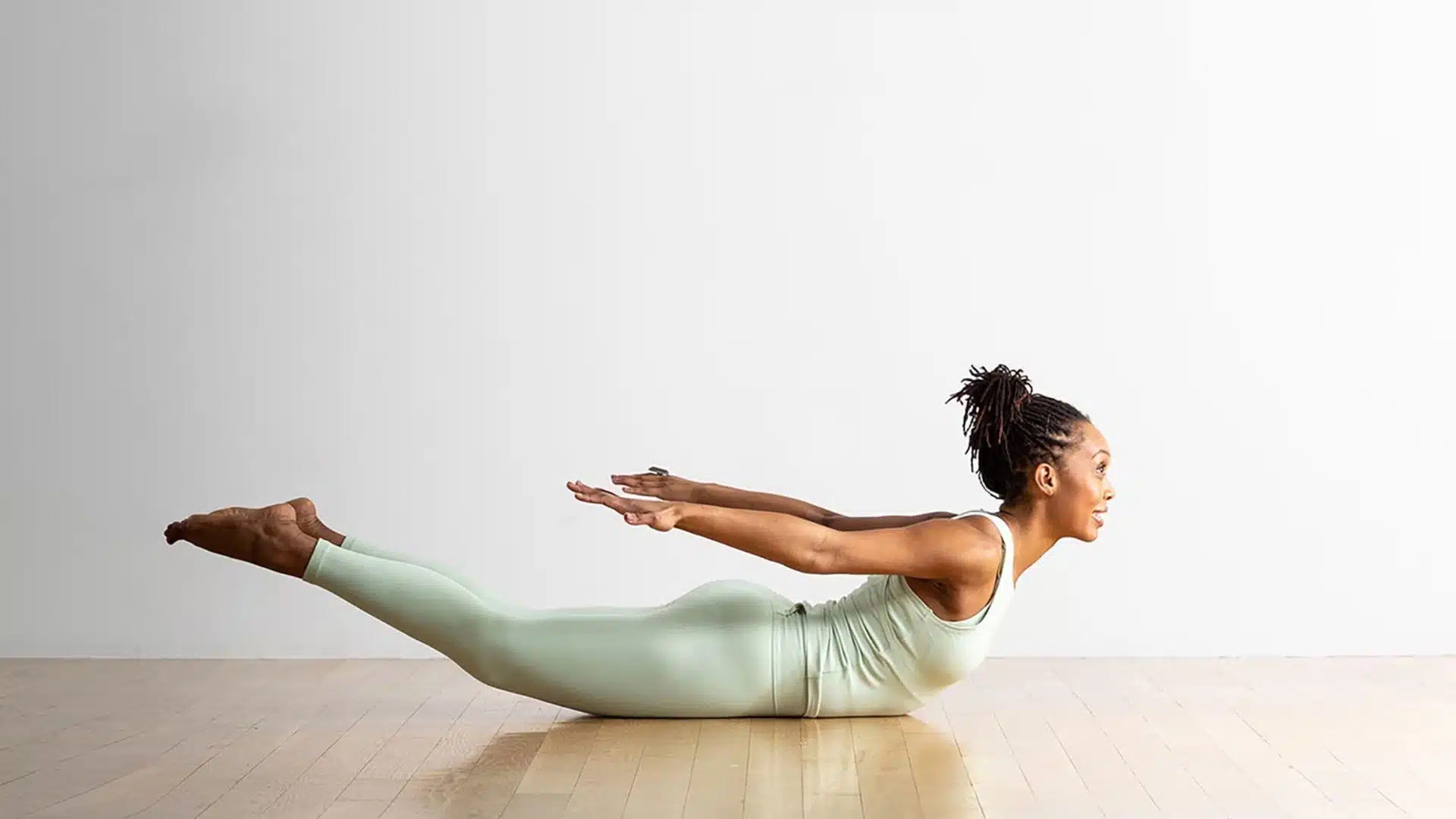

In this prone pose, both legs, arms, and chest lift off the floor as your body rests on the belly. Lie face down with arms beside your hips and legs together. Inhale deeply, lift your chest, arms, and legs simultaneously.
Keep your neck long, legs strong, and shoulders drawn back while holding the lifted shape and breathing steadily.
Benefits
- Strengthens back, glutes, and shoulders
- Improves posture and spinal alignment
- Builds full-body awareness
26. Full Side Plank (Vasisthasana with leg lift)
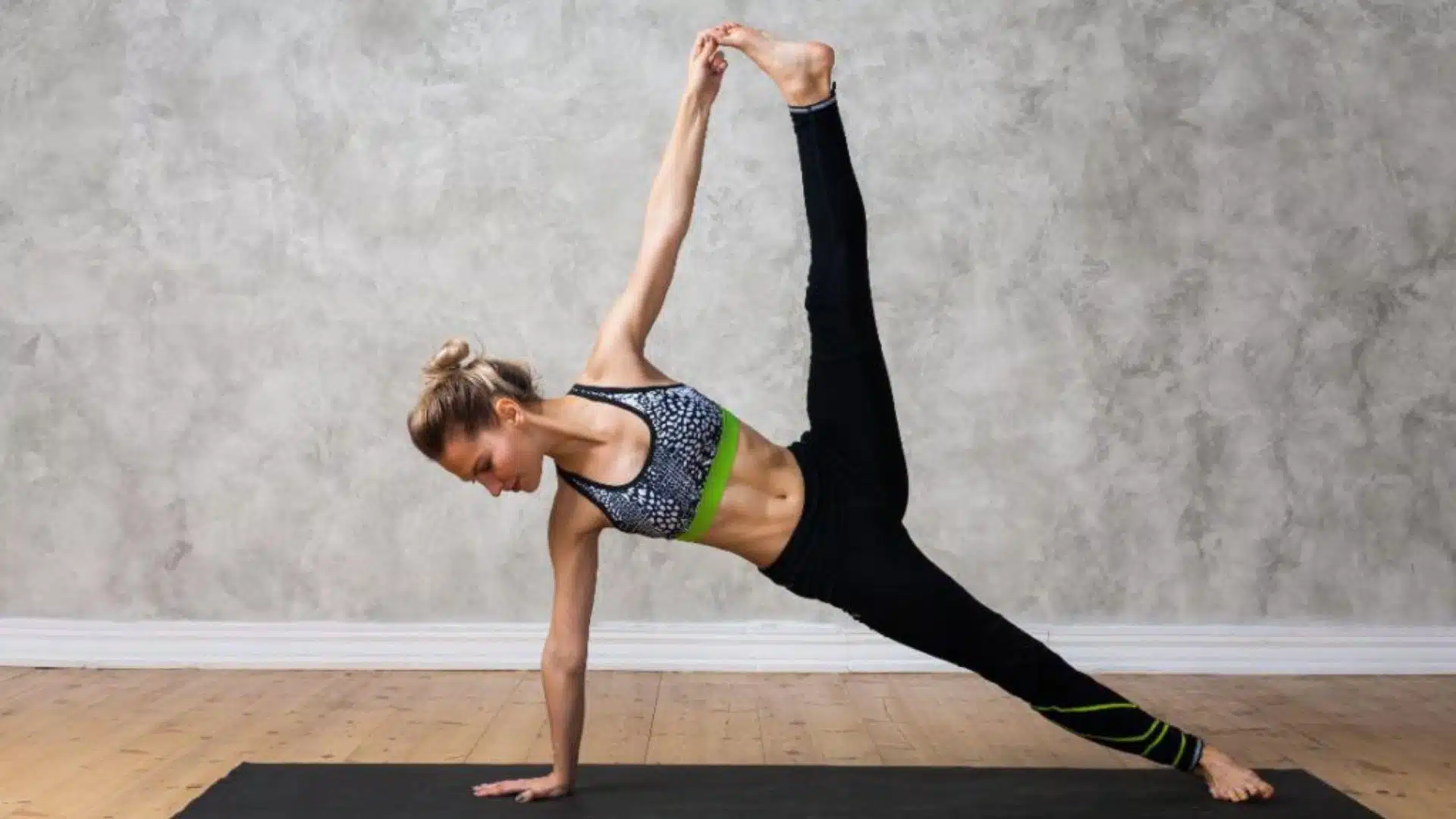

This balance pose stacks your body sideways while one hand supports, and the top leg lifts upward in the air. Start in side plank with one foot stacked over the other. Grab your top foot with your upper hand.
Lift the top leg straight toward the ceiling while keeping your bottom arm strong and the body fully aligned.
Benefits
- Strengthens arms and obliques
- Improves core and hip control
- Improves balance and mobility
27. Sage Koundinya I (Eka Pada Koundinyasana I)


This arm balance has one leg extended forward and the other stretched back while the body twists over bent elbows.
Start in a lunge twist, place hands on the floor, and lean forward until elbows bend and feet lift. Extend the front leg straight and reach the back leg behind as your torso stays low and strong.
Benefits
- Strengthens core and arms
- Improves twisting flexibility
- Develops balance and coordination
28. Sage Koundinya II (Eka Pada Koundinyasana II)


This variation extends both legs in opposite directions while the body balances on bent arms close to the ground. Begin in a lunge, twist, and lower your torso forward. Plant your hands shoulder-width apart and lean forward into your arms.
Lift your front leg straight ahead and the back leg straight behind, keeping your body supported through strong shoulders.
Benefits
- Builds strength and flexibility
- Improves balance and focus
- Opens hips and hamstrings
29. Sage Visvamitrasana
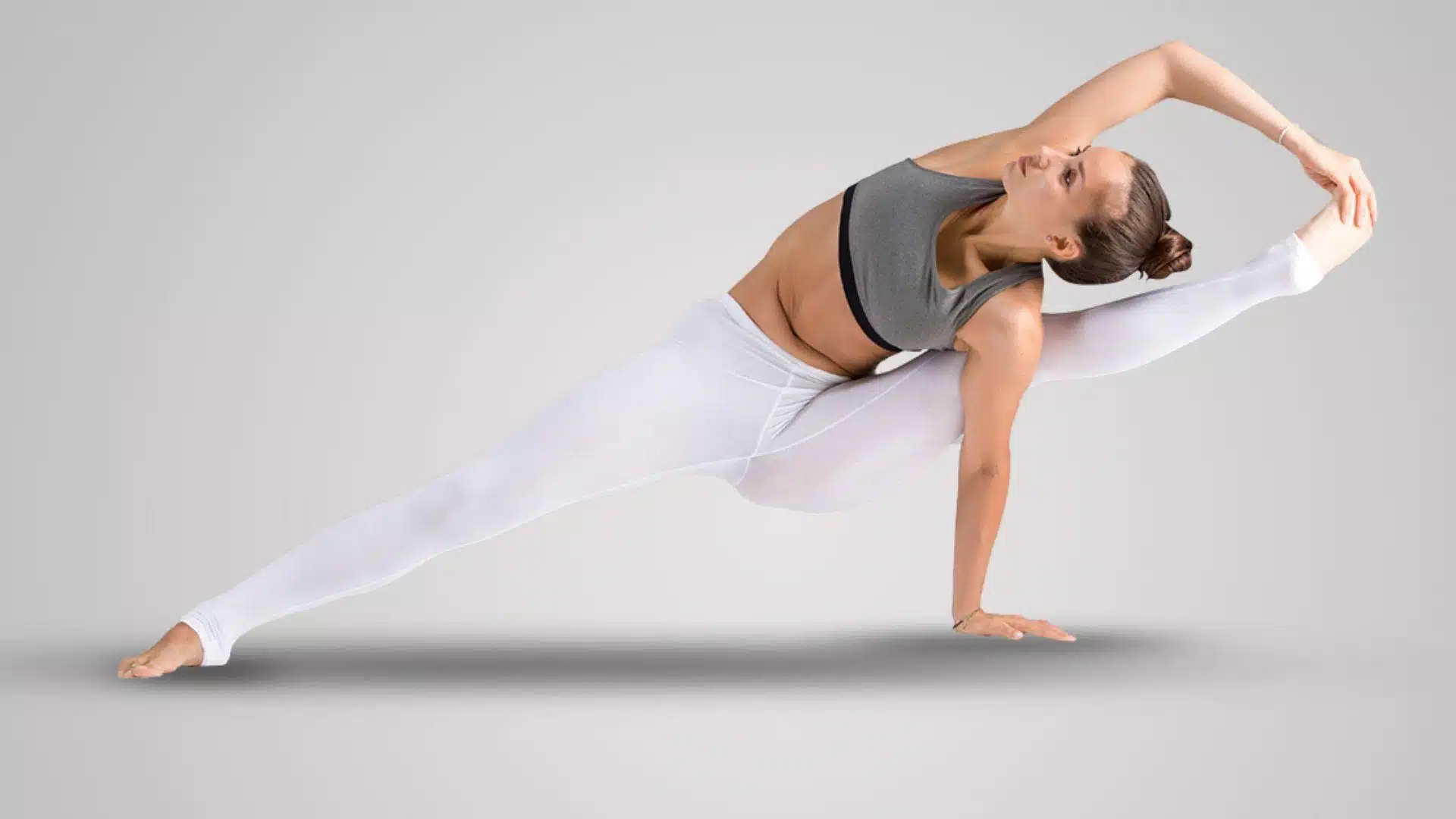

This pose mixes a side plank, deep twist, and hamstring stretch with one leg extended up and held by your hand. Start in a low lunge with one leg forward and both hands down. Thread the arm under the front thigh.
Grab the front foot with your hand and extend the leg to the side while keeping the supporting arm straight.
Benefits
- Improves side body flexibility
- Strengthens shoulders and core
- Opens hips and legs
30. Revolved Head-to-Knee Pose (Parivrtta Janu Sirsasana)
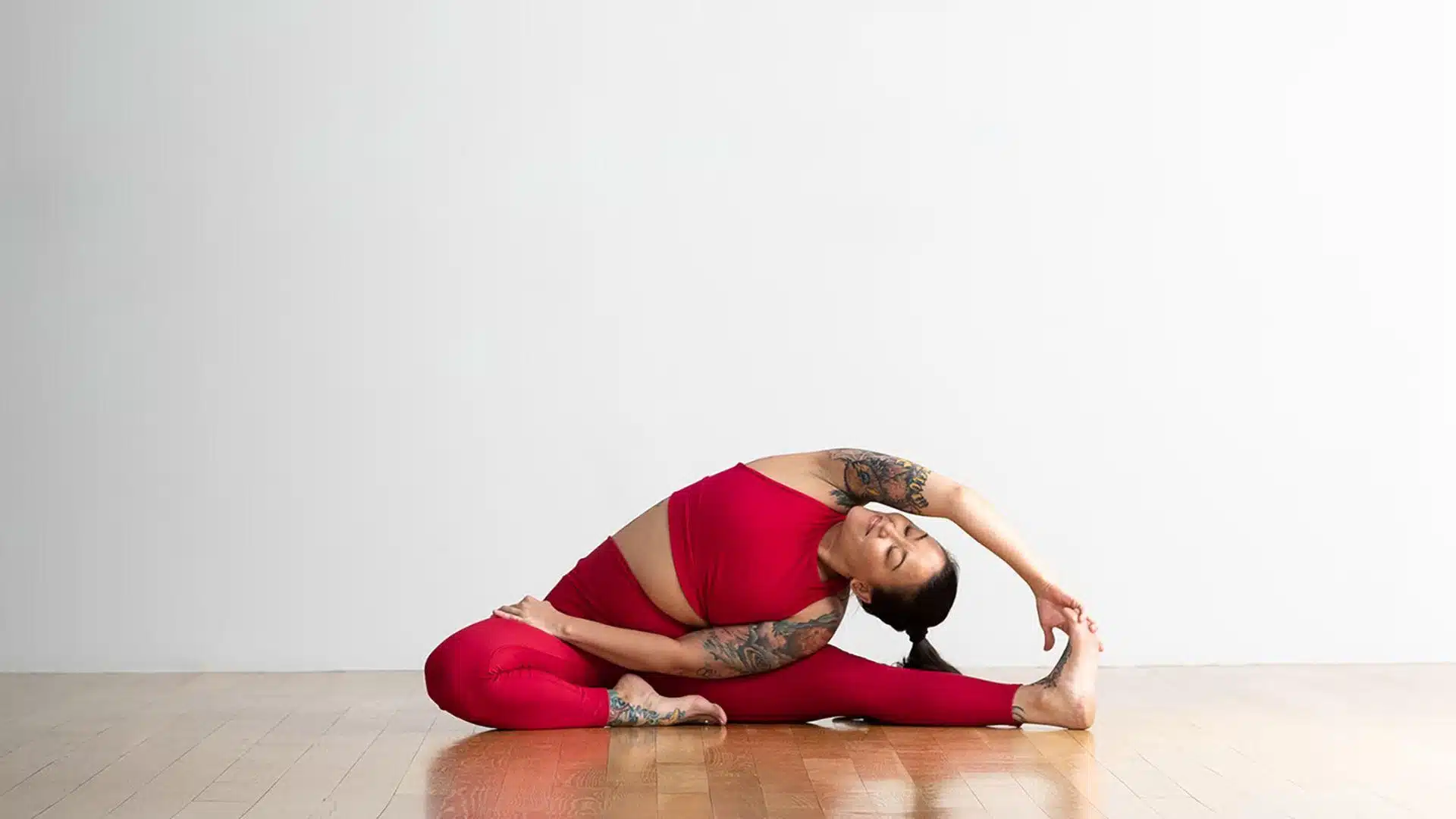

This seated twist stretches the side body and hamstrings while reaching one arm over the head toward the extended foot. Start seated with one leg extended and the other foot tucked near the inner thigh.
Twist your torso toward the bent knee, reach your opposite arm over, and fold sideways toward the extended foot.
Benefits
- Improves spinal flexibility
- Opens the side body and hamstrings
- Encourages gentle twisting
31. Bow Pose (Dhanurasana)
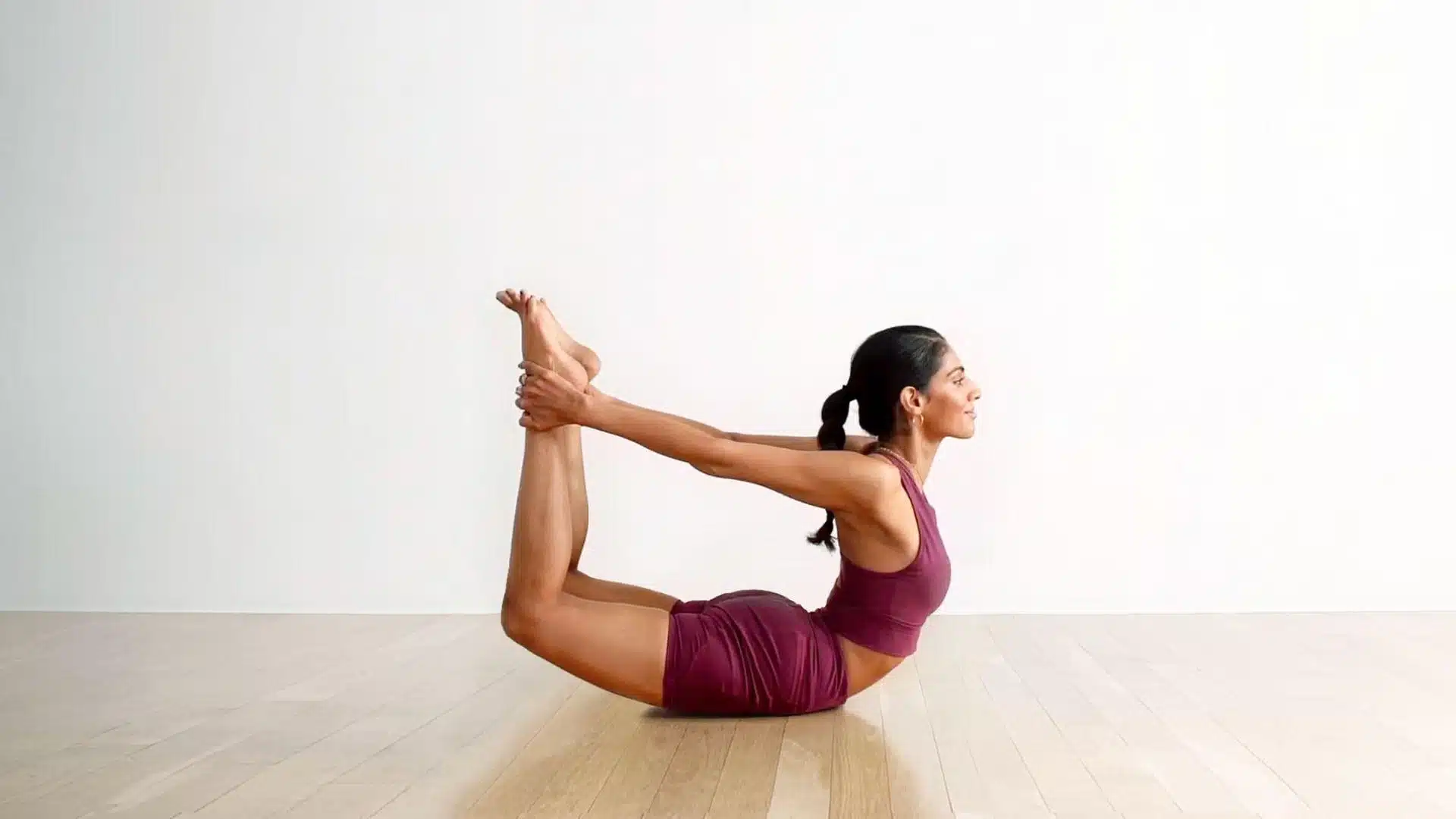

This backbend is performed lying on your belly, lifting your chest and legs by pulling your ankles with your hands. Start on your stomach, bend both knees, and reach back with your hands to grab your ankles.
Kick your feet into your hands, lift your thighs and chest, and keep your gaze forward while holding the pose.
Benefits
- Stretches the front body
- Strengthens the back and legs
- Encourages energy and lift
32. Noose Pose (Pasasana)


This squatting twist binds the arms around the legs while keeping the feet flat and chest turned to the side. Begin in a deep squat with both heels grounded. Twist your torso to one side, wrapping your arm around the knees.
Reach your other arm behind your back and clasp the hands together while keeping your chest open and spine long.
Benefits
- Improves spinal rotation
- Opens shoulders and chest
- Tone legs and core
33. Lord of the Dance Pose (Natarajasana, full variation)
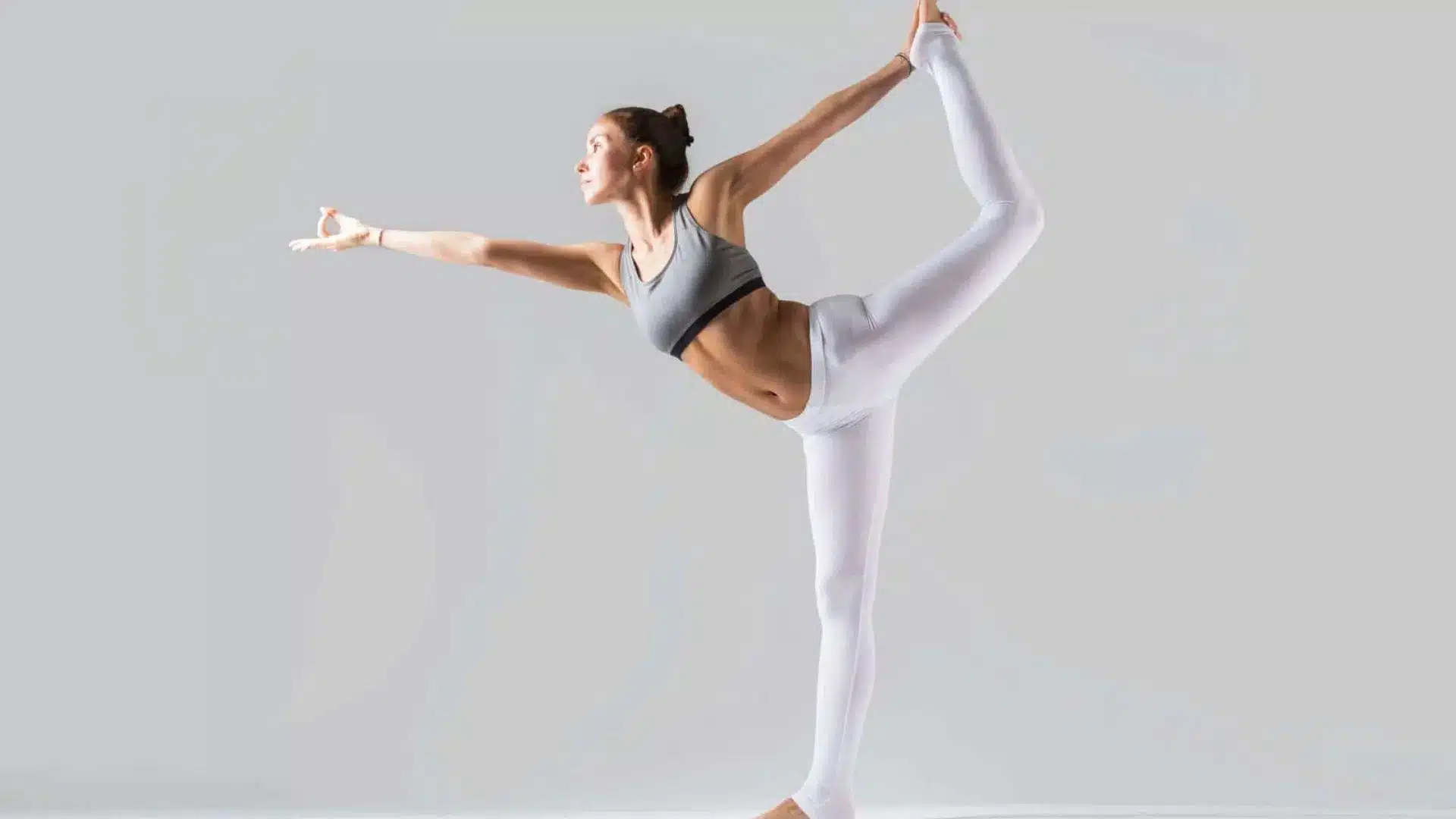

This advanced balance and backbend lifts one leg behind you with both arms reaching overhead to grasp the lifted foot. Begin standing, bend one leg, and reach both arms back to catch the foot or ankle behind your body.
Lift the chest, pull the foot higher, and keep the body strong and steady as you balance and stretch upward.
Benefits
- Deepens backbend
- Improves focus and poise
- Strengthens the entire body
34. Wheel Pose with Leg Lift (Urdhva Dhanurasana Eka Pada)


This variation lifts one leg while holding the full wheel backbend, creating more strength and balance in the lifted pose. Start in regular wheel pose with hands and feet pressing into the mat.
Once stable, shift your weight and slowly raise one leg off the floor, extending it straight while staying lifted and controlled.
Benefits
- Builds full-body strength
- Increases spinal flexibility
- Improves control and stability
35. Standing Hand to Big Toe Pose
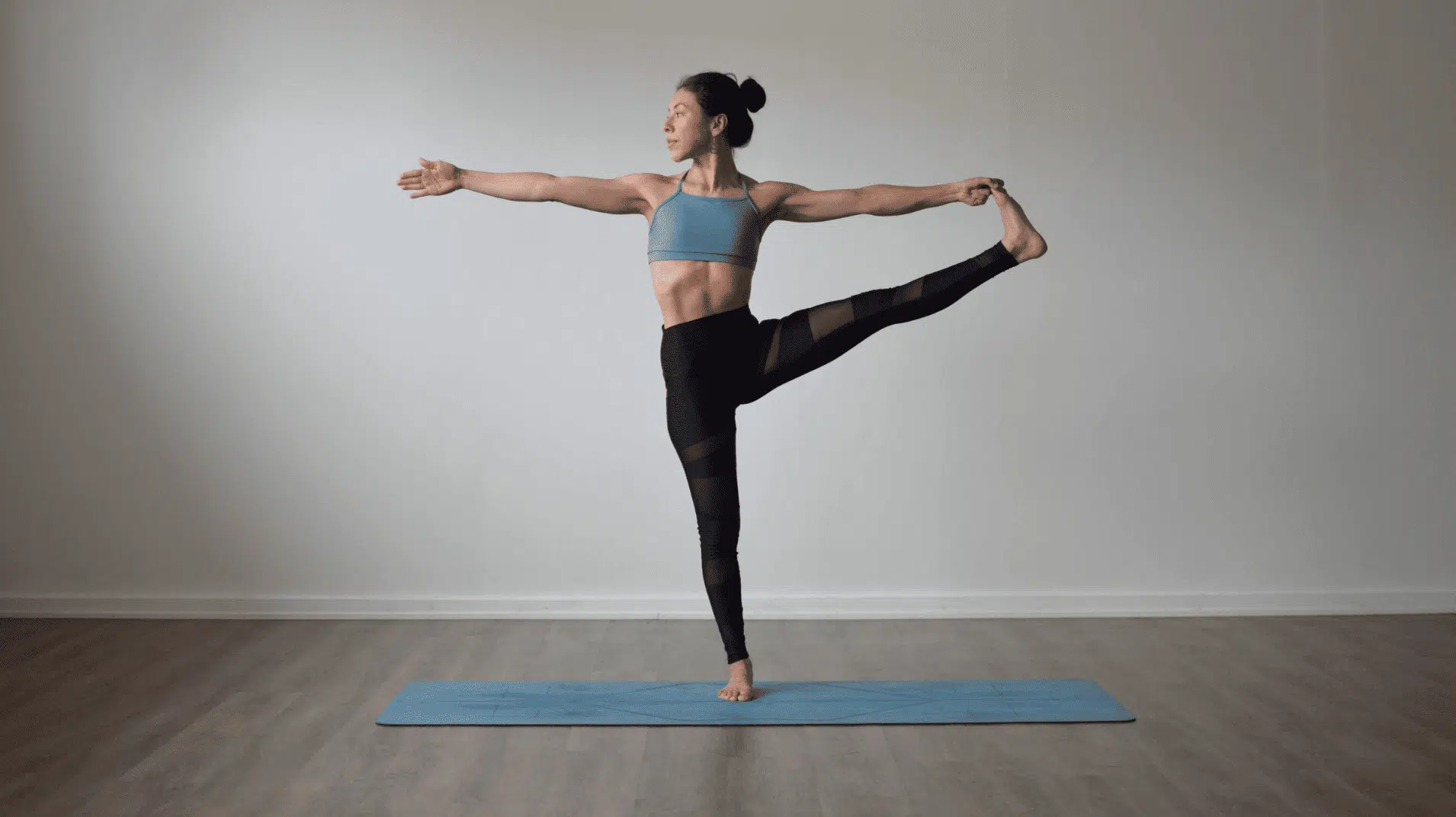

Standing Hand to Big Toe Pose or Utthita Hasta Padangusthasana, advanced, extends one leg forward or to the side while holding the big toe with the same-side hand. Start standing tall, lift one leg, and grab the big toe using your hand while keeping your spine upright.
Extend the leg straight in front or out to the side while maintaining balance and keeping your standing leg strong.
Benefits
- Improves balance and coordination
- Stretches hamstrings and calves
- Strengthens legs and hips
36. Rabbit Pose (Sasangasana, deep variation)


This kneeling pose rounds the spine as you tuck your head toward the knees and lift the hips overhead. Begin seated on your heels, reach back and hold your heels.
Tuck your chin into your chest, place the top of your head on the mat, and lift your hips gently upward.
Benefits
- Stretches the upper spine
- Releases tension in the shoulders
- Calms the nervous system
37. Deep Camel Pose (Ustrasana, advanced grip)


This is a kneeling backbend where hands grasp the feet with chest lifted and thighs pressing forward strongly. Begin on your knees with hands on your lower back. Press your hips forward and slowly arch your back.
Reach for your heels with both hands, drop your head back, and lift your chest while keeping thighs vertical and active.
Benefits
- Opens chest and hip flexors
- Strengthens the back and glutes
- Encourages confident posture
How to Progress Toward Hard Yoga Poses
Breaking down challenging poses into manageable steps makes them feel less scary and more achievable. These proven strategies will help you build skills gradually while keeping your body safe and healthy.
- Start with easier versions of your target pose that use the same basic movements and muscle groups
- Build specific strength and flexibility by practicing exercises that directly support your challenging pose goals daily
- Practice short holds and drill movements rather than trying to perfect the full pose right away
- Focus on showing up consistently for practice instead of obsessing over making your poses look absolutely perfect
- Take progress photos or keep a simple journal to track small improvements that you might not notice day-to-day
Following these steps turns impossible-looking poses into realistic goals that you can actually reach over time. Your patience and consistent effort will pay off with stronger skills and greater confidence in your practice.
Tips for Training in These Yoga Poses Safely
Difficult yoga poses require smart preparation and patience to avoid injury while building your skills. These essential strategies will help you progress safely without pushing your body beyond its current limits.
- Always warm up with gentle movements and basic poses before attempting any advanced or challenging positions
- Practice specific strength and flexibility exercises that target the muscles and joints your goal pose requires
- Focus on steady, controlled breathing to stay calm and centered when your body feels stressed or unstable
- Remember that progress takes months or years, so celebrate small improvements instead of expecting perfect poses immediately
Following these safety guidelines will help you build a strong foundation for advanced practice over time. Your body will thank you for taking the slow, steady approach that prevents injuries and burnout.
Final Words
I hope you feel inspired to start working toward poses that once seemed completely impossible for your current skill level.
You now understand that every advanced practitioner started exactly where you are right now, feeling intimidated by difficult positions. Your experience will be unique, filled with small victories that build into major breakthroughs over time and consistent practice.
I can’t wait to hear about your first success with a pose that used to scare you. Remember that every expert was once a complete beginner who refused to give up on their dreams.
Comment below and tell me which challenging pose you’re most excited to conquer first!

